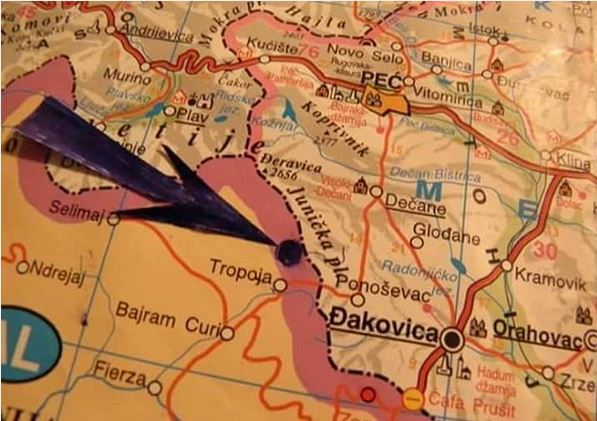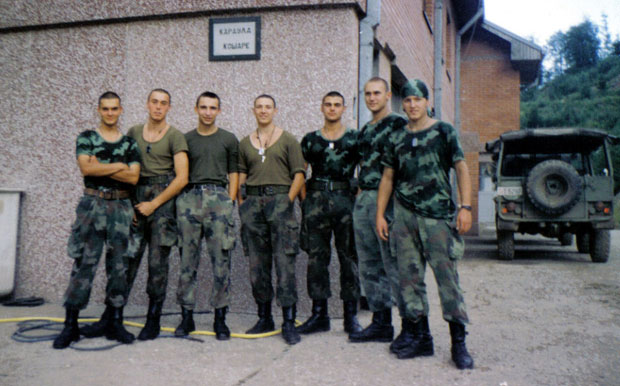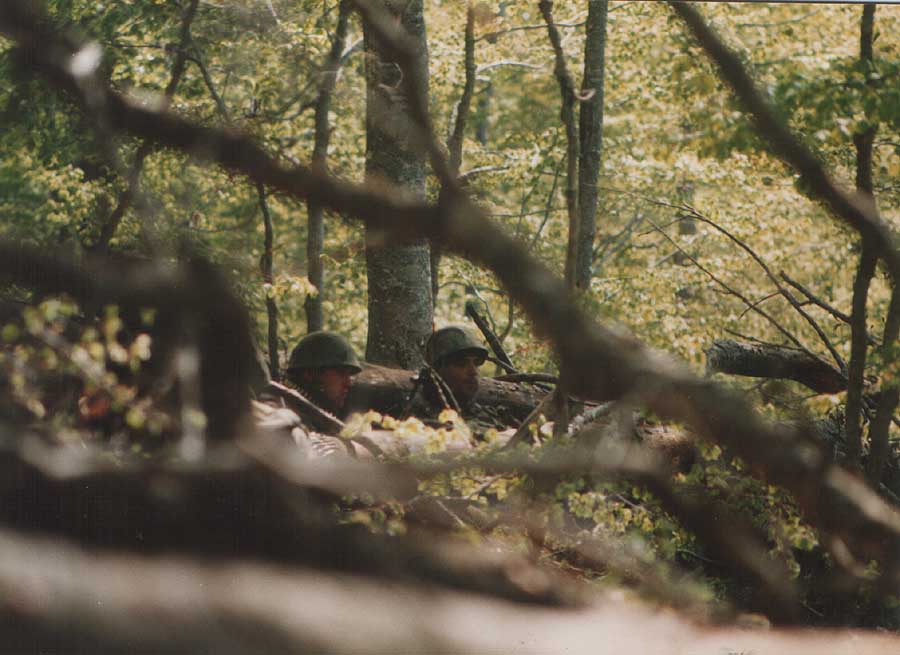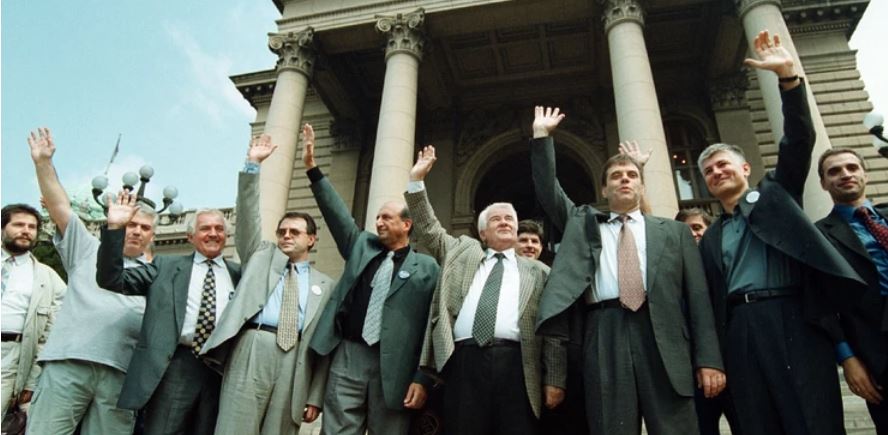Period:
Yugoslav Wars
Region:
Kosovo and Metohia
The Battle of Koshare 1999
The Battle of Koshare was a fierce conflict between the Army of the Republic of Yugoslavia and the members of the Albanian terrorist group known as KLA which was supported by the regular Army of Albania, the members of the French Foreign Legion, British special units SAS, and NATO aviation.

Location of thebattle on the Serbia-Albania border
The Battle of Koshare was fought at the border crossing Rrasa e Koshares between the Republic of Serbia and the Republic of Albania, from 9 April until 10 June 1999, in the midst of the NATO bombing of Serbia and Montenegro.
The aim of Albanians was land invasion known as “Operation Arrow” of the territory of Kosovo and Metohija and cutting off communication lines between units of the Army of Yugoslavia in Djakovica and Prizren. Another aim was to occupy the extensive part of the Metohija region during this attack. After serious combat, the Army of Yugoslavia defeated the attackers and prevented them from entering Kosovo.
The members of Albanian KLA managed to seize the peak of Koshare temporarily with the assistance of the Army of Albania, NATO aviation, and because of the fact that a small number of Serbian soldiers protected this point and were forced to retreat. Despite enjoying assistance, they were eventually prevented from getting into the territory through that crossing.
THIS BATTLE IS SEEN AS ONE OF THE BITTEREST AND BLOODIEST BATTLES OF SERBIAN PEOPLE IN THE 20th CENTURY
BACKGROUND
On On 15 January 1999, in the Kosovo village of Račak, Serbian police clashed with Albanian terrorists. The Western Media falsely reported that Serbian policemen killed Albanian civilians. They were instructed by William Walker, the head of the Kosovo Verification Mission.

Holbrooke in Belgrade with false offer
This case served as justification for the aggression and bombing of Serbia and Montenegro in 1999, which the Government of Serbia attempted to avoid in negotiations with Kosovo Albanians in Rambouillet. As this attempt failed, American general Wesley Clark ordered the bombing, which turned into genocidal action known as “Merciful Angel.”
THE PLANS OF KLA AND NATO
The plans of the NATO alliance and Albanians were to defeat units of the Army of Yugoslavia at the border crossing Koshare to allow the members of the KLA and regular Army of Albania to enter the territory of Kosovo with the final aim to initiate the open war with the Army of Yugoslavia. The open war would have allowed NATO to bomb positions of the Army of Yugoslavia because it hitherto failed to destroy its units. Plans also included invasion of the Metohija region and defeat of the Army of Yugoslavia. The invasion refuted the widespread belief that the NATO aggression didn’t include land invasion.
Preparation of the attack
Events that preceded the beginning of NATO aggression on 24 March 1999, included periodical and bloody exchange of fire between Yoguslavian and Albanian frontier guards, the latter being supported by KLA. The conflicts occurred because the Yugoslavian frontier guard took all their efforts to prevent illegal transport of weapons into the territory of Kosovo. During their offensive at the end of 1998, Serbian forces successfully broke KLA in the territory of Kosovo and Metohija whose members managed to reach the territory of Albania in small groups where they were filled with more soldiers and sent to Kosovo again. After Rambouillet negotiations from February 1999 had failed, preparation for invading the territory of Kosovo was on the way.
The day of 24 March 1999 was when the NATO aggression began with the primary reason to get the Army of Yugoslavia out of the territory of Kosovo. NATO warplanes bombed positions of the Army of Yugoslavia at the border crossing between Yugoslavia and Albania. Around 12,000 NATO soldiers, and 5,000 Americans among them, arrived in Albania, bringing 30 tanks and 26 “Apache” helicopters while a number of Albanian civilians were leaving Kosovo. At the beginning of the aggression, there were some periodic conflicts but it was not before 9 April 1999 that KLA had started invasion of Kosovo across the peak of Koshare where they were in advantage. This was due to the fact that positions of the KLA and Albanian army were on higher altitude than positions of the Serbian army. The peak itself was extremely inconvenient to defend so it was chosen as one of the main points for invasion.

The Heroes: soldiers of the 63th Parachute Regiment at Koshare 1999
ATTACK
On 9 April 1999, the day of Orthodox Good Friday, at 3:00 Albanians started an extensive artillery fire towards the peak of Koshare. The fire was initiated by the Army of Albania towards the border positions of the Army of Yugoslavia. During the attack, the enemy used cannons, howitzers, mine throwers, and the assault itself was coordinated by the members of the French Foreign Legion.
Albanians conducted attacks from three directions, first towards the peak of Koshare, second towards the border post at Koshare, and last towards the peak of Maje Glava. During the artillery fire, around 1,500 KLA terrorists reached the border unnoticed. At that moment, less than 120 soldiers of the Army of Yugoslavia, members of the 53rd Border Battalion, were on the first line.
The bloody battle lasted the whole day with a great number of casualties, especially on the side of invaders. In the afternoon, KLA seized the peak of Rrasa e Koshares and immediately took a defensive position. They used this opportunity to bring several artillery weapons up to the peak. The battle continued during the night until the next morning.
With the help of artillery, KLA seized the peak of Maje Glava and continued with shelling of the border post Koshare. In the afternoon, the soldiers of the Yugoslavian Army had to leave the border post. At 19:00 members of KLA entered the abandoned post, and the international media, such as CNN and BBC, reported that a large number of KLA members seized the border post of Koshare. Soldiers of the Army of Yugoslavia retreated to the second line of defense above the border post. These positions were easier to defend. The next day the Army of Yugoslavia received an additional number of soldiers and artillery. A group of KLA members was positioned above the positions of the Yugoslavian Army to cut communication lines. They managed to destroy one combat vehicle.
During the night, KLA attacked positions of the Yugoslavian Army at the peak of Opljaz, trying to break the defense of Serbian soldiers, but the attack was forced back with a number of casualties on the side of attackers, although they were backed up by the artillery. In the next few days, KLA tried to break the defense of the second line of defense but this ended with failure. The Army of Yugoslavia brought members of special units, war veterans and several more artillery weapons.

Serbian soldiers in wood
Reorganization of positions and counterattack
Albanian artillery continued with shelling of Serbian positions from the Maje Glava and Rrasa e Koshares peaks. The Army Command of Yugoslavia decided to initiate an unexpected counterattack. On 14 April 1999, soldiers of the Army of Yugoslavia started an attack on the Maje Glava peak. Distance between the two opponent ditches wasn’t longer than 50 meters. The Army of Yugoslavia failed to seize the entire peak of Maje Glava, but it forced artillery to cease fire from that peak. The front at Maje Glava remained steady by the end of the war, without any changes at the lines.
During the second half of April, the Rrasa e Koshares peak didn’t see any changes on the front lines and both sides suffered significant losses. Soldiers of the Yugoslavian Army suffered casualties from artillery fire, and Albanians from a series of unsuccessful attacks on the defense lines of the Yugoslavian Army.
Combats in May
The beginning of May 1999 witnessed the unsuccessful effort of the Yugoslavian Army to take the border post of Koshare back, which was stopped with artillery fire. On Saint George Day, 6 May, the Yugoslavian Army began a counterattack against the KLA positions at the peak of Koshare to force artillery to stop. The bloody battle was fought with a lot of casualties on both sides, but the Yugoslavian Army failed to seize Koshare.
On 10 May, the Army Command of Yugoslavia sent two tanks T-55 to support the attack on Rrasa e Koshares. Tanks were successfully driven across an impenetrable terrain, and l00 meters of territory was seized, but KLA still held the peak. During the night, NATO warplanes threw cluster bombs on Yugoslavian soldiers who attacked KLA positions under the peak, thus killing 8 soldiers, 1 officer, and wounding 40 soldiers of the Yugoslavian Army. This was essential for the Albanian successful defense from Yugoslavian soldiers.
In the middle of May, great battles were fought at the Mrcaj peak which was taken over by the Yugoslavian Army when KLA suffered a great number of casualties. After this, KLA had to retreat from these positions and the Yugoslavian Army gained an advantage on the terrain for coordination of artillery fire. This allowed the Yugoslavian Army to stabilize the terrain and hold the enemy out of the defense lines. The bloody battle of Koshare was fought until 10 June 1999 without any changes.

Mihailo Medenica, a journalist who was the first to visit Koshare border post
THE END
The war in Kosovo lasted until 10 June 1999 when the Military agreement was signed in the town of Kumanovo which implied the retreat of Yugoslavian army and police from Kosovo. NATO entered Kosovo disguised as peacekeeping troops under the name KFOR, and KLA was disarmed (at least theoretically).
On 10 June, 1999 The UN Security Council brought the Resolution 1244 in New York, according to which the international force UNMIK tоок over Kosovo and Metohija, and the Army of Yugoslavia was allowed to bring 1,000 soldiers back to Kosovo in due time.
YEARS LATER...
A year after the end of NATO aggression Serbia faced the replacement of the regime in October 2000. The government was formed by democratic option, and leading politicians, Vojislav Koštunica, Zoran Djindjić, Vladan Batić, Vesna Pešić put an effort to build “friendly” relations with the countries which took part in aggression against Serbia and Montenegro.

The military and police hierarchy went through an extensive purge of cadre when most of the generals and officers were retired or replaced in the period 2001-2004. Many of them were delivered to the Hague Tribunal where they were sentenced to many years of imprisonment due to fake reports on the alleged war crimes.
The story about the heros who defended our fatherland in its southern parts, was covered by media silence. Everyone who tried to share information about what was happening during the ‘90s war, faced the persecution and arrest. After 2012, the situation changed on some level.
Soldiers who died in Kosovo and Metohija are still left without a proper monument in the centre of Belgrade, and other cities in Serbia.
CASAULTIES
The battle of Koshare took many lives away on both sides. Official data show that the Yugoslavian army lost 60 soldiers in the area of Koshare peak, with a Russian volunteer Bulah Glebovich, among them. Casualties on the KLA side were more than 150 soldiers. 80% of them came from Kosovo, and there is no exact number of Albanians who came from Albania and Vardar Macedonia.
Officially, the three foreign soldiers were found dead during the battle, a French- Arnod Pier (1971), an Italian- Francesco Giuseppe Bidder (1961), and Murad Mohammed Alija from Algeria. During the battle, 5 Albanian tanks were destroyed and the tank offensive has been completely broken.

Below is the list of some names of Koshare heroes:
-
Lieutenant colonel- Dragutin Dimcevski
-
Corporal- Slavoljub Sarac
-
Major- Mikica Kovacevic
-
Lieutenant- Oliver Mladenovic
-
Senior sergeant- Ivica Lazic Francuz
-
Sladjan Stefanovski
-
Captain Boban Kuzmanovic Joker
-
Sergeant Zlatko Solunac
-
1st class sergeant Sladjan Stefanovic Stef
-
Sergeant major Srdjan Lalic
-
Lance sergeant Predrag Obradov
-
Sergeant major Ivica Miladinovic
-
1st class sergeant Boban Ostojic
-
14th captain of 1st class Zivic
The names of Serbian soldiers who died during the Battle of Koshare
-
Sаšа Škiljеvić
-
Ivan Vasоjević
-
Branislav Negić
-
Dragan Мilićević
-
Мirоslаv Stојаnоvić
-
Vladimir Radоičić
-
Gоran Оstоjić
-
Zlatkо Acić
-
Dejan Мitić
-
Darkо Bjelоbrk
-
Мilеnkо Bоžić
-
Ilija Pavlоvić
-
Мiladin Gоbeljić
-
Aleksandar Kisin
-
Мirоslav Jоcić
-
Ivаn Bоgоsаvljеvić
-
Оliver Тaričić
-
Drаgаn Dušаnić
-
Rаdоš Cеrоvić
-
Predrag Leоvac
-
Prеdrаg Bоgоsаvljеvić
-
Ivica Petkоvić
-
Stојаdin Тоmаšеvić
-
Ivаn Vаsојеvić
-
Sаšа Ivаnkоvić
-
Drаgаn Мilоšеvić
-
Slаvkо Krunić
-
Bulаh Glеbоvič
-
Nаsеr Vučеlj
-
Nikоlа Јоsić
-
Drаgi Lаlić
-
Мilаn Јеvtоvić
-
Bојаn Јоvаnоvić
-
Đurо Grdеljеvić
-
Stојаdin Тоmаšеvić
-
Drаgаn Мilićеvić
-
Мilаdin Dоgаndžić
-
Prеdrаg Мilаnоvić
-
Ivicа Ivаnоvić
|
-
Rаdišа Ilić
-
Srđаn Stаnčеtić
-
Мilоmir Rоmić
-
Zоrаn Мiјаtоvić
-
Krunоslаv Ivаnkоvić
-
Dејаn Kоstić
-
Тibоr Cerna
-
Sаšа Kоmаtоvić
-
Rаdе Аntоnić
-
Zоrаn Vеsеlić
-
Мilоš Pavlоvić
-
Drаgаn Kоmаricа
-
Dаnilо Vојvоdić
-
Тоmislаv Kоstić
-
Vlаdislаv Bulаtоvić
-
Ljubišа Bоžilоv
-
Nеnаd Gоlubоvić
-
Мirоslаv Маrinkоv
-
Stојаn Pоpоvić
-
Vlаdimir Nеstоrоvić
-
Мilаn Јоkić
-
Мilоsаv Јоšоvić
-
Јоsip Sič
-
Ivicа Pеtkоvić
-
Drаgаn Мilојеvić
-
Rоbеrt Stоšić
-
Ivаn Мihајlоvić
-
Stаnоје Јоvаnоvić
-
Аlеksаndаr Kisin
-
Prеdrаg Bојоvić
-
Vlаdimir Đоrđеvić
-
Zоrаn Filipоvić
-
Bојаn Bоgојеvić
-
Rаdоvаn Pеrić
-
Drаgаn Pеtkоvić
-
Drаgаn Маrinkоvić
-
Zоrаn Stајić
-
Nоvicа Stаnkоvić
-
Dејаn Мisirlić
|
The Battle of Koshare, as one of the greatest battles in the history of Serbian nation, has become an inspiration for numerous Serbian poets and writers who wrote poems and books about the battle and its heroes. Some of their names are - Milutin Popadić, Nenad Milkić, Marko Marković, Slavko Perošević, etc.
Documentaries have been also made, and one of the newest is The War Stories from Koshare produced by the Ministry of Defense, Military Film Centre “Zastava Film” and Radio-Television of Serbia.
Tags:
Please, vote for this article:
Visited: 5838 point
Number of votes: 57
|